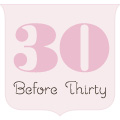
Five Things That Inspire Me
My time in the Blog it Forward lineup has come, and today I'm sharing with you the things that inspire…March 11, 2010
DIY Painting Tips, Tricks, and a Step-by-Step Guide
My dad was a handyman, and I grew up helping him. I've painted my home from top to bottom, as…March 9, 2010
Martha Stewart Paint Colors
I was informed today by Jules that the new line of Martha Stewart paint colors is now at The Home…March 3, 2010
30 Before Thirty
I will turn thirty on September 22, 2010. That gives me a little more than six months to do all…March 1, 2010
Inspiration Board
I made something last night. It's my attempt at an "inspiration board", though I confess I think of it more…February 8, 2010
The Wish List
Have you checked out the wish list page recently? There are lots of goodies over there. I keep going back…January 18, 2010

Five Things That Inspire Me
My time in the Blog it Forward lineup has come, and today I’m sharing with you the things that inspire me. Femininity The unapologetically pretty.…

DIY Painting Tips, Tricks, and a Step-by-Step Guide
My dad was a handyman, and I grew up helping him. I’ve painted my home from top to bottom, as well as the houses and…

Martha Stewart Paint Colors
I was informed today by Jules that the new line of Martha Stewart paint colors is now at The Home Depot. People, do you realize…

30 Before Thirty
I will turn thirty on September 22, 2010. That gives me a little more than six months to do all of the things on this…

Inspiration Board
I made something last night. It’s my attempt at an “inspiration board”, though I confess I think of it more as a big rectangle of…

The Wish List
Have you checked out the wish list page recently? There are lots of goodies over there. I keep going back and forth with the idea…
